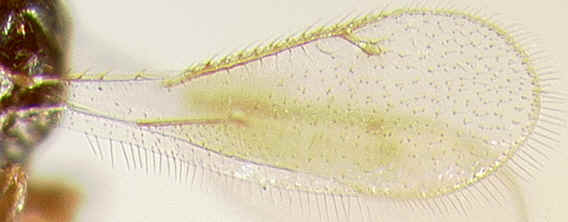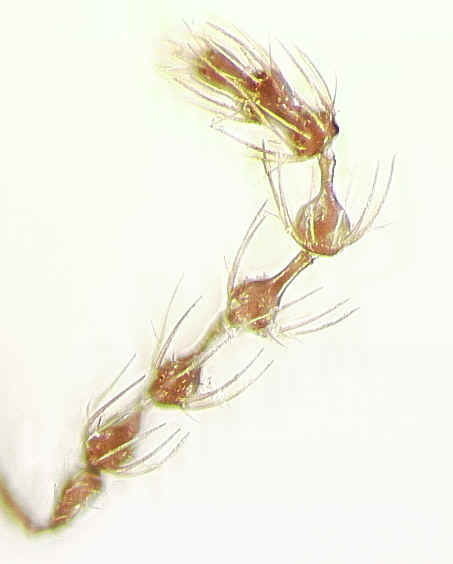

1a-b: Carlyleia forewing (left), female and male antenna (right)
return to: Eul 1 Eul 4 eul 1 ent 1 eud1 eud5
Carlyleia
Girault, 1916 comparative info return to: prev home
Males with nodose flagellomeres bearing only 1 whorl of long setae. Forewing
without fuscate regions; no rows of setae radiating from stigma. Propodeum
without median carina. Gt1 without carinae; last gastral tergite much longer than
preceding tergite in females. Compare with: Allocerastichus, Parasecodella,
Euderus.


1a-b: Carlyleia forewing (left), female and male antenna (right)
2a: Carlyleia gaster (female)
Biology:
Comments: 1 described species: C. marilandica Girault. A very unusual Entiine species in that there are no setal tracks radiating from the stigmal apex.
Comparative information:
Allocerastichus: Gt1 with 2-3 dorsal carinae in females. Forewing with 2 rows of setae radiating from stigmal apex. Antennal radicle elongate, nearly as long as pedicel.
Parasecodella: Propodeum with median carina. Apical gastral tergite shorter than preceding tergite in females. Male antenna with more than one whorl of long setae on at least some segments.
Euderus: Apical gastral tergite shorter than preceding tergite in females. Males of most species with flagellomeres not nodose, similar to those in females, but if nodose than with more than one whorl of long setae on at least some segments. Most species with 2-3 rows of setae radiating from stigmal apex. Propodeum with median carina in most species.
References
Coote, L.D. 1994. Review of Nearctic genera of Euderinae (Hymenoptera: Eulophidae), with descriptions of two new species of Allocerastichus Masi, and redescription of Carlyleia marilandica Girault. Canadian Journal of Zoology. 72: 1044-1054.
Image credits: 2a: Coote (1994).